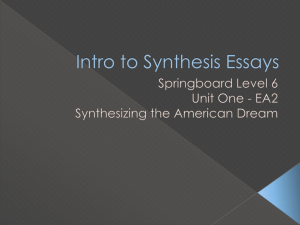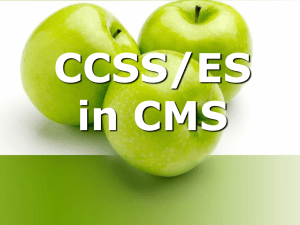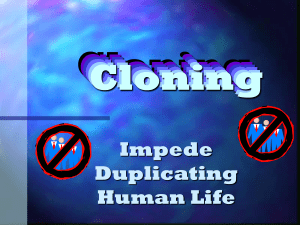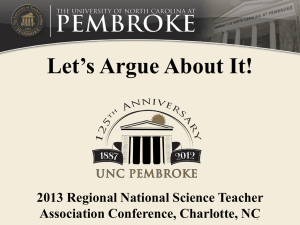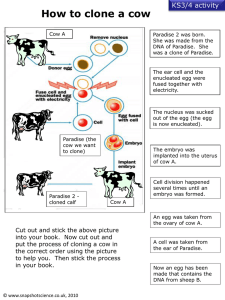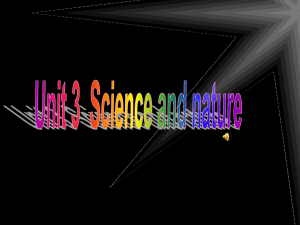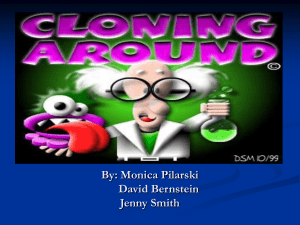Why scientific argumentation? - The University of North Carolina at
advertisement
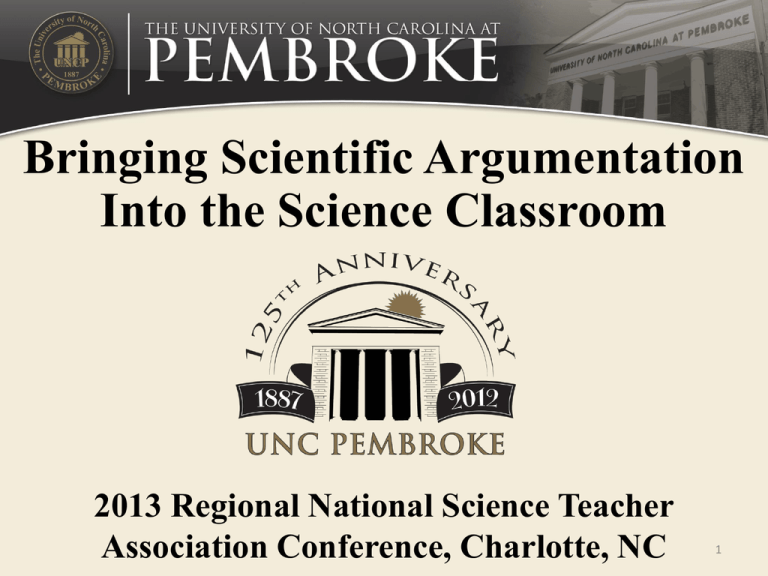
Bringing Scientific Argumentation Into the Science Classroom 2013 Regional National Science Teacher Association Conference, Charlotte, NC 1 AGENDA 1) Why Scientific Argumentation? Dr. Rita Hagevik, Graduate Director of Science Education MA and MAT in middle and secondary science education and MA non-licensure in science education degrees 2) Classroom Examples and Activities a) Corinne Jordan (MA HS)– GM foods (claim, evidence, justification) b) David Wimert (MA MG)– Energy (alternative explanation and rebuttal) c) Ursula Adams (MAT HS) – Cloning (rebuttal and refutational writing) 3) Things to remember when planning and teaching scientific argumentation 3) Handouts and additional information can be found at www.uncp.edu/biology (science education link on left hand side of webpage) 5) Other resources from NSTA - Questions? Why scientific argumentation? Argumentation is about making claims and providing justification for those claims. 3 When should students use arguments? A. To refute claims made by other students B. To defend their claims, designs, and questions C. Science is about evidence and reasoning so students should never argue D. To prove a point 4 What scientific argumentation is NOT a debate but what scientists do everyday! Scientists engage in argument to • Defend claims using evidence and reasoning • Defend models using evidence • Critique the claims of other scientists and look for sufficient and appropriate evidence 5 Reasons scientists use arguments Interpretation of data Experimental designs Method of data analysis The appropriateness of a questions “Observation and experiment are not the bedrock upon which science is built; rather they are handmaidens to the rational activity of constituting knowledge claims through argument (Newton, Driver, Osborne 2000).” 6 Stephen E. Toulmin The Uses of Argument (1958, revised 2003) Cambridge University Press Toulmin’s Model 1) Claim 2) Fact/Grounds/Data (Evidence) 3) Warrant (Chain of Reason) 4) Backing 5) Rebuttal 6) Qualifier What does it look like in the classroom? 1. 2. 3. 4. Evaluate your data and discuss as a group MAKE a Claim (Answer the real world question) List your evidence and reasoning (rationale) Write your claim, evidence and reasoning The Research Question Your Claim Your Evidence Your Reasoning Rebuttals: Summary of your argument: The Good, the Bad, and Genetically Modified Corn Corinne Jordan Graduate Research Assistant MA Science Education (High School) What Do These Foods have In Common? GMO corn PRO’S CON’S • Improved farming practicesreduced fuel consumption, less tilling • Reduced effectiveness of pesticidesinsects resistant to engineered toxins • Cold tolerance • Loss of biodiversity • Increased nutrition • “Super weeds”- a bacterial toxin BT producing BT resistant bugs • Reduced cost of produced food • Disappointing crop yields • Reducing world hunger • Effects of reduced tilling? • Reduced use of herbicides and pesticides • Possible negative health implications • Spend less money STUDENT EXAMPLES PRO CONS So how much GMO food production globally? 8 Labeling of GM foods is not mandatory unless there is a health or safety concern (Health Canada/Canadian Food Inspection Agency) David Wimert 8th Grade Science Tar Heel Middle School Bladen County, North Carolina Renewable Vs. Non-renewable Resources Alternative Explanation and Rebuttal Is where students select the one claim they agree on and then justify why they think it was the best claim. Energy Argumentation Alternative Explanation and Rebuttal 1. To begin the module….. Students are introduced to the module task and given the question that they will research. “Energy is a part of life that society cannot live without. With fossil fuels being more convenient and efficient; should society continue with its current energy source or is it time for change?” 2. Students are given the key concept words and concepts associated with renewable and non-renewable energy by conducting a lab, watching videos, PowerPoints, and doing research. 3. Students are then given time to conduct research on the topic. Renewable Vs. Non-renewable Resources Alternative Explanation and Rebuttal 4. After students perform their research, they will develop their claim, find evidence to support their claim, and then justify their evidence. 5. After the claim, evidence, and justification is complete, students select the one claim they agree on and then justify why they think it was the best claim. Renewable Vs. Non-renewable Resources Alternative Explanation and Rebuttal With emphasis placed on the Common Core and the North Carolina Essential Standards, scientific writing in the form of argumentation is key to bringing science and the common core together. Ursula Adams Cloning Around UNC Pembroke MAT Secondary Science The Generation of Tentative Arguments and Counterarguments • Reminds students of the research questions and what counts as appropriate evidence in science • Requires students to generate an argument that provides and supports a claim with genuine evidence • Suggests that a model, diagram, or representation is created • Asks students what opposing ideas or rebuttals they might anticipate • Provides related theories and reference materials as tools Pros Cons *Reproductive cloning places an altered human cell in a woman’s uterus *Therapeutic cloning covers an array of scientific possibilities such as stem cell research and other forms of nonreproductive cloning *Scientists have the necessary technical training to make informed decisions about cloning *The processes for therapeutic cloning and reproductive cloning both share a fundamental act: the destruction of human embryos *Therapeutic cloning is wrong because it requires the creation of human beings only so that they may be “harvested” for the betterment of other human beings *Humanity cannot leave decisions about human cloning to the “experts” Possible Arguments and Counterarguments for Cloning Safety * It is undisputed that cloning is currently an untested technology. Safety is the only valid argument against human cloning. Medical need *There is no medical reason for reproductive cloning. There are biological and social reasons, other than medical reasons, for human cloning. Human dignity * Identical twins are natural clones. Identical twins have the same mitochondrial DNA, and thus will be more ‘identical’ than clones produced through cloning technology (with different mothers). Cloning is a threat to human diversity *Arguments against reproductive cloning on the basis that it reduces genetic diversity are flawed. 23 An Argumentation Session • Reminds students of appropriate and safe behaviors in the learning community • Encourages students to ask their peers the questions that the teacher asked in the previous stage • Keeps the discussion focused on the evidence and data • Encourages students to use appropriate criteria for determining what does and does not count Refutational Writing • Helps students to: – Not only learn but learn how to do scientific writing – Make sense of his/her experience – To learn how to articulate their thinking in a clear precise manner – Encourages metacognition and improves students understanding of the content Poll: supporting students in construction arguments What do you think will be most challenging about incorporating argumentation into your teaching? A. Having students use evidence B. Providing alternative explanations C. Students being respectful of other students’ ideas D. Supporting students in writing arguments 26 Student Challenges • Using evidence to support their ideas – Can rely on their own opinions and/or have difficulty using sufficient evidence • Explaining why their evidence supports their ideas – Can have difficulty articulation this link and/or using scientific principles • Considering alternative claims – Can focus on one idea • Revising arguments based on new evidence • Taking into consideration the viewpoints of others 27 How can I support students in arguments? 1. 2. 3. 4. 5. Provide a framework Model and describe the framework Provide them with examples Let them know why it is important Have them critique each other’s written arguments 6. Allow them to debate ideas 7. Provide them with various scaffolds 28 More Information • Lessons and handouts can be found at www.uncp.edu/biology • NSTA journals and the NSTA has webinars on teaching scientific argumentation • McNeill (elementary and middle) and Sampson (high school) books • The Next Generation Science Standards (2013) Questions?? • Rita Hagevik, rita.hagevik@uncp.edu • Corinne Jordan, caj018@bravemail.uncp.edu • David Wimert, dw0017@bravemail.uncp.edu • Ursula Adams, ul0001@bravemail.uncp.edu www.uncp.edu/biology for handouts and ppts
